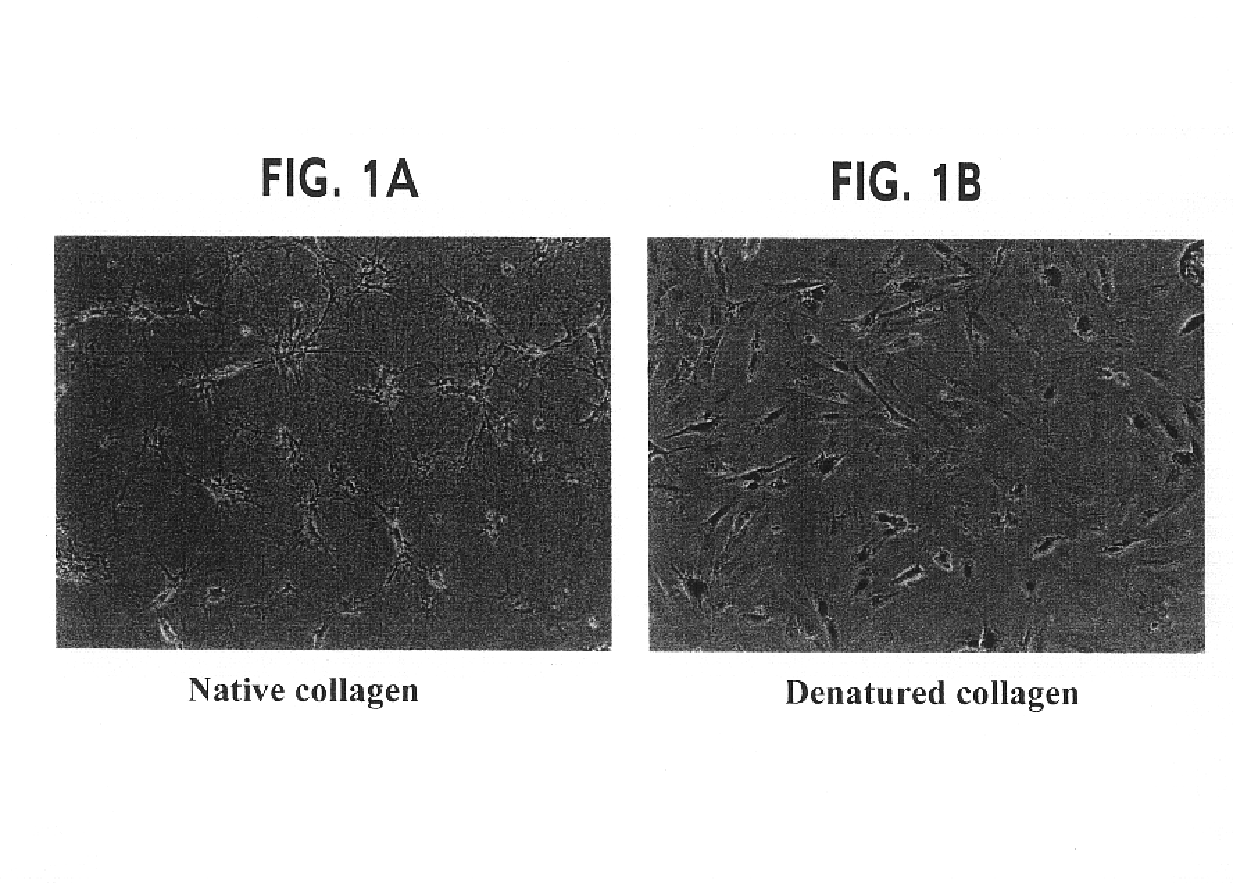Methods and compositions for enhancing the delivery of a nucleic acid to a cell
a nucleic acid and cell technology, applied in the field of methods and compositions for enhancing the delivery of nucleic acid to a cell, can solve the problems of undesirable use of nucleic acid analogs, inability of previously described vector and delivery system combinations to efficiently deliver nucleic acids into the interior of cells of a targeted population, and difficulty in targeting naked nucleic acid vectors to particular animal tissues. , to achieve the effect of enhancing the permissiveness, enhancing the efficiency of the nu
- Summary
- Abstract
- Description
- Claims
- Application Information
AI Technical Summary
Benefits of technology
Problems solved by technology
Method used
Image
Examples
example 1
[0128]The objective of the experiments described in this example was to ascertain whether denatured collagen, which is able to provoke a marked change in cell shape to a shape hypothesized to enhance the cytoskeletal permissiveness of a cell for transfection with a nucleic acid, would be effective at enhancing the extent of transfection of cells. The results of these experiments indicated that denatured collagen was effective at enhancing the efficiency of delivery of a nucleic acid to a cell, thus increasing the extent of transfection observed in the cells.
[0129]Rat arterial smooth muscle cells (A10 cells) grown on denatured collagen and native fibrillar type I collagen were studied. A change in cell shape from stellate to elongated with reorientation of the actin-stress fibers was observed. When these cells were transfected with a nuclear targeted beta-galactosidase plasmid (CMV promoter) complexed with cationic lipid (Lipofectamine®), greater than 20% of the cells (FIGS. 1 and 2)...
example 2
[0131]The objective of the experiment described in this Example was to ascertain whether Tenascin C itself was able to enhance the cytoskeletal permissiveness of a cell for transfection with a nucleic acid, thereby resulting in an increase in the extent of transfection of cells grown on native collagen containing Tenascin C relative to cells grown on native collagen alone. The results of these experiments indicated that Tenascin C itself was effective at enhancing the efficiency of delivery of a nucleic acid to a cell, thus increasing the extent of transfection.
[0132]A10 cells were grown on native type I collagen containing 0, 15 and 50 micrograms per milliliter of Tenascin C. The cells were transfected with p-EGFP-N3 (green fluorescent protein) plasmid DNA. Twenty-four hours after transfection, the fluorescence of cells grown on the native type I collagen containing 0, 15 and 50 micrograms per milliliter of Tenascin C (FIGS. 4A, 4B and 4C, respectively) was assessed. A bright field...
example 3
[0134]The objective of the experiment described in this Example was to ascertain whether cytochalasin D was able to enhance the cytoskeletal permissiveness of a cell for transfection with a nucleic acid, thereby resulting in an increase in the extent of transfection of cells provided cytochalasin D relative to cells which were not provided cytochalasin D. Cytochalasin D is an agent known to depolymerize F-Actin to G-Actin. The results of this experiment indicated that cytochalasin D itself was effective at enhancing the efficiency of delivery of a nucleic acid to a cell, thus increasing the extent of transfection.
[0135]A10 cells were grown on native type I collagen. The cells were transfected with p-EGFP-N3 (green fluorescent protein) plasmid DNA as described above. Immediately after lipofection, cytochalasin D at a final concentration of 1 nanomolar was either added to cells for thirty minutes, added to cells for an overnight incubation or not added at all (control). The fluorescen...
PUM
| Property | Measurement | Unit |
|---|---|---|
| molecular weights | aaaaa | aaaaa |
| molecular weights | aaaaa | aaaaa |
| concentration | aaaaa | aaaaa |
Abstract
Description
Claims
Application Information
 Login to View More
Login to View More - R&D
- Intellectual Property
- Life Sciences
- Materials
- Tech Scout
- Unparalleled Data Quality
- Higher Quality Content
- 60% Fewer Hallucinations
Browse by: Latest US Patents, China's latest patents, Technical Efficacy Thesaurus, Application Domain, Technology Topic, Popular Technical Reports.
© 2025 PatSnap. All rights reserved.Legal|Privacy policy|Modern Slavery Act Transparency Statement|Sitemap|About US| Contact US: help@patsnap.com



